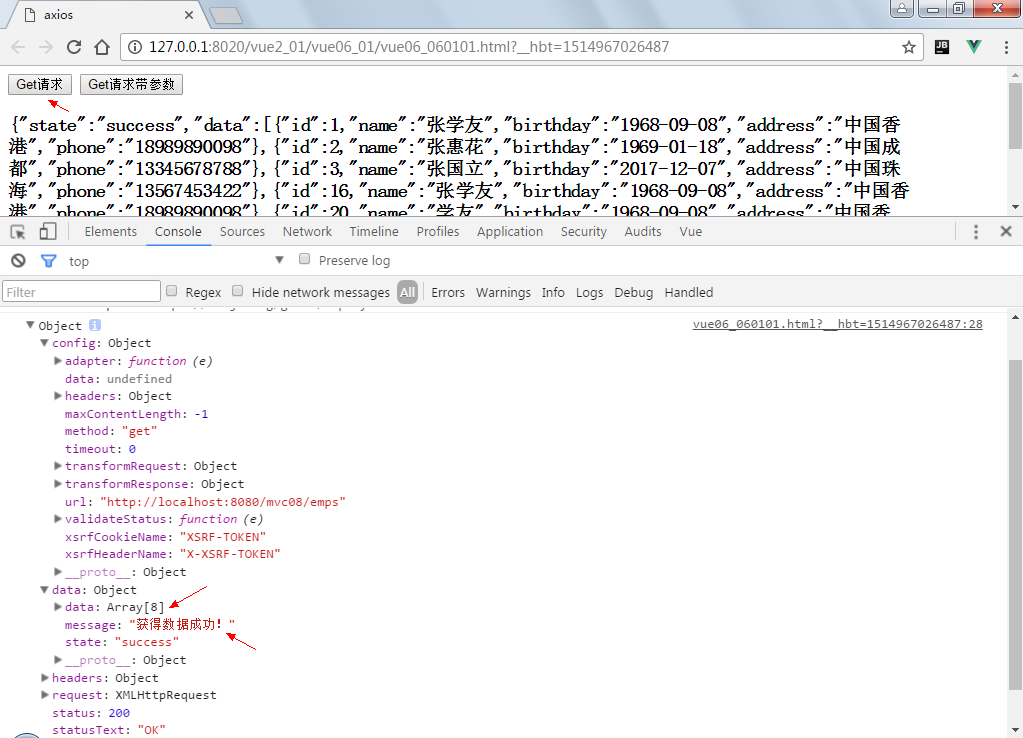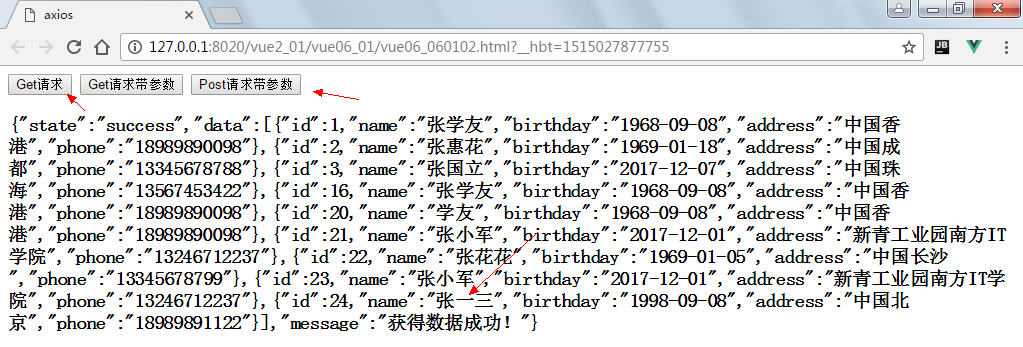一、axios Vue更新到2.0之後宣告不再對vue-resource更新,推薦使用axios,axios是一個用於客戶端與伺服器通信的組件,axios 是一個基於Promise 用於瀏覽器和 nodejs 的 HTTP 客戶端javaScript工具。通俗來說可以實現客戶端請求伺服器端提供的服務 ...
一、axios
Vue更新到2.0之後宣告不再對vue-resource更新,推薦使用axios,axios是一個用於客戶端與伺服器通信的組件,axios 是一個基於Promise 用於瀏覽器和 nodejs 的 HTTP 客戶端javaScript工具。通俗來說可以實現客戶端請求伺服器端提供的服務獲得數據。
源碼與幫助:https://github.com/axios/axios
伺服器端跨域支持請查看:http://www.cnblogs.com/best/p/6196202.html#_label2
1.1、特點
- 從瀏覽器中創建 XMLHttpRequest
- 從 node.js 發出 http 請求
- 支持 Promise API
- 攔截請求和響應
- 轉換請求和響應數據
- 取消請求
- 自動轉換JSON數據
- 客戶端支持防止 CSRF/XSRF
1.2、瀏覽器相容性

1.3、依賴辦法
$ npm install axios $ cnpm install axios //taobao $ bower install axios 或者使用cdn: <script src="https://unpkg.com/axios/dist/axios.min.js"></script>
瀏覽器可以引入js文件
1.4、快速入門
1.4.0、伺服器端
控制器:
package com.zhangguo.springmvc08.controller; import com.zhangguo.springmvc08.entity.User; import com.zhangguo.springmvc08.service.UserService; import org.springframework.beans.factory.annotation.Autowired; import org.springframework.web.bind.annotation.*; import javax.servlet.http.HttpServletRequest; import javax.servlet.http.HttpServletResponse; import java.util.List; @RestController @RequestMapping(path = "/emps") public class EmpController extends BaseController { @Autowired UserService userService; @RequestMapping(path = "") public AjaxState getAllEmps(HttpServletRequest request, HttpServletResponse response) { List<User> users=userService.queryAllUsers(); boolean result=users!=null; return new AjaxState(result?"success":"error",users,result?"獲得數據成功!":"獲得數據失敗!"); } @RequestMapping(path = "/{id}", method = RequestMethod.GET) public AjaxState getEmpById(@PathVariable int id) { User user=userService.getUserById(id); boolean result=user!=null; return new AjaxState(result?"success":"error",user,result?"獲得數據成功!":"獲得數據失敗!"); } @RequestMapping(path = "/getEmpById", method = RequestMethod.GET) public AjaxState getEmpById(HttpServletRequest request) { int id=Integer.parseInt(request.getParameter("id")); User user=userService.getUserById(id); boolean result=user!=null; return new AjaxState(result?"success":"error",user,result?"獲得數據成功!":"獲得數據失敗!"); } @RequestMapping(path = "", method = RequestMethod.POST) public AjaxState addEmp(@RequestBody User user) { boolean result=userService.addUser(user); return new AjaxState(result?"success":"error",user,result?"添加成功!":"添加失敗"); } @RequestMapping(path = "", method = RequestMethod.PUT) public AjaxState updateEmp(@RequestBody User user) { boolean result=userService.editUser(user); return new AjaxState(result?"success":"error",user,result?"修改成功!":"修改失敗"); } @RequestMapping(path = "/{id}", method = RequestMethod.DELETE) public AjaxState deleteEmpById(@PathVariable int id) { Boolean result=userService.deleteUser(id); return new AjaxState(result?"success":"error",id,result?"刪除成功!":"刪除失敗"); } } class AjaxState{ public String state; public Object data; public String message; public AjaxState(String state, Object data, String message) { this.state = state; this.data = data; this.message = message; } public AjaxState(){} }
跨域設置(任選一種):
方法1:Servlet,MVC都可以,Web.xml
<filter> <filter-name>CORS</filter-name> <filter-class>com.thetransactioncompany.cors.CORSFilter</filter-class> <init-param> <param-name>cors.allowOrigin</param-name> <param-value>http://127.0.0.1:8020</param-value> </init-param> <init-param> <param-name>cors.supportedMethods</param-name> <param-value>POST,GET,OPTIONS,DELETE,PUT</param-value> </init-param> <init-param> <param-name>cors.supportedHeaders</param-name> <param-value>Content-Type,Accept,Origin,XRequestedWith,ContentType,LastModified</param-value> </init-param> <init-param> <param-name>cors.exposedHeaders</param-name> <param-value>SetCookie</param-value> </init-param> <init-param> <param-name>cors.supportsCredentials</param-name> <param-value>true</param-value> </init-param> </filter> <filter-mapping> <filter-name>CORS</filter-name> <url-pattern>/*</url-pattern> </filter-mapping>
方法2:Spring MVC,修改Spring 配置文件,低Spring版本不支持
<mvc:cors> <mvc:mapping path="/**" allowed-origins="http://127.0.0.1:8020" allowed-methods="POST,GET, OPTIONS,DELETE,PUT" allowed-headers="Content-Type,ContentType,Access-Control-Allow-Headers, Authorization, X-Requested-With" allow-credentials="true"/> </mvc:cors>
1.4.1、發送Get請求
//向具有指定ID的用戶發出請求 axios.get('/user?ID=123') .then(function (response) { console.log(response); }) .catch(function (error) { console.log(error); }); //也可以通過 params 對象傳遞參數 axios.get('/user', { params: { ID: 12345 } }) .then(function (response) { console.log(response); }) .catch(function (error) { console.log(error); });
示例:
<!DOCTYPE html> <html> <head> <meta charset="UTF-8"> <title>axios</title> </head> <body> <div id="vm"> <button type="button" @click="get">Get請求</button> <button type="button" @click="getParam">Get請求帶參數</button> <h3>{{msg}}</h3> </div> <script src="../js/vue.js" type="text/javascript" charset="utf-8"></script> <script src="../js/axios/axios.min.js" type="text/javascript" charset="utf-8"></script> <script type="text/javascript"> var vm = new Vue({ el: "#vm", data: { msg: "" }, methods: { get: function() { var that = this; axios.get("http://localhost:8080/mvc08/emps").then(function(response) { console.log(response); //this.msg=JSON.stringify(response.data); //錯誤this指向window vm.msg = JSON.stringify(response.data); that.msg = JSON.stringify(response.data); }).catch(function(error) { console.log(error); }) }, getParam: function() { axios.get("http://localhost:8080/mvc08/emps/getEmpById", { params: { id: 1 } }).then(function(response) { vm.msg = JSON.stringify(response.data); }).catch(function(error) { console.log(error); }) } } }); </script> </body> </html>
結果:
get請求

帶參數:

預設的content-type為:application/json;charset=UTF-8
1.4.2、發送Post請求
axios.post('/user', {
firstName: 'Fred',
lastName: 'Flintstone'
})
.then(function (response) {
console.log(response);
})
.catch(function (error) {
console.log(error);
});
示例(添加一個用戶):

<!DOCTYPE html> <html> <head> <meta charset="UTF-8"> <title>axios</title> </head> <body> <div id="vm"> <button type="button" @click="get">Get請求</button> <button type="button" @click="getParam">Get請求帶參數</button> <button type="button" @click="post">Post請求帶參數</button> <h3>{{msg}}</h3> </div> <script src="../js/vue.js" type="text/javascript" charset="utf-8"></script> <script src="../js/axios/axios.min.js" type="text/javascript" charset="utf-8"></script> <script type="text/javascript"> var vm = new Vue({ el: "#vm", data: { msg: "" }, methods: { get: function() { //get請求 var that = this; axios.get("http://localhost:8080/mvc08/emps").then(function(response) { console.log(response); //this.msg=JSON.stringify(response.data); //錯誤this指向window vm.msg = JSON.stringify(response.data); that.msg = JSON.stringify(response.data); }).catch(function(error) { console.log(error); }) }, getParam: function() { //帶參數的get axios.get("http://localhost:8080/mvc08/emps/getEmpById", { params: { id: 1 } }).then(function(response) { vm.msg = JSON.stringify(response.data); console.log(response); }).catch(function(error) { console.log(error); }) }, post: function() { //post var user = { "id": 1, "name": "張一三", "birthday": "1998-09-08", "address": "中國北京", "phone": "18989891122" }; axios .post("http://localhost:8080/mvc08/emps", user) .then(function(response) { vm.msg=response.data.data; console.log(response); }) .catch(function(error){ console.log(error); }); } } }); </script> </body> </html>View Code
結果:

1.4.3、發送多個併發請求
function getUserAccount() { return axios.get('/user/12345'); } function getUserPermissions() { return axios.get('/user/12345/permissions'); } axios.all([getUserAccount(), getUserPermissions()]) .then(axios.spread(function (acct, perms) { //兩個請求現已完成 }));
示例(同時獲得編號為1與編號為2的學生,通過兩個請求完成):
<!DOCTYPE html> <html> <head> <meta charset="UTF-8"> <title>axios</title> </head> <body> <div id="vm"> <button type="button" @click="all">all請求(併發請求)</button> <h3>{{msg}}</h3> </div> <script src="../js/vue.js" type="text/javascript" charset="utf-8"></script> <script src="../js/axios/axios.min.js" type="text/javascript" charset="utf-8"></script> <script type="text/javascript"> var vm = new Vue({ el: "#vm", data: { msg: "" }, methods: { all:function(){ //獲得用戶對象1 var getUser1=function(){ return axios.get("http://localhost:8080/mvc08/emps/1"); }; //獲得用戶對象2 var getUser2=function(){ return axios.get("http://localhost:8080/mvc08/emps/2"); }; //併發請求處理結果 axios.all([getUser1(),getUser2()]) .then(axios.spread(function(response1,response2){ var result=""; result+=JSON.stringify(response1.data.data); result+=JSON.stringify(response2.data.data); vm.msg=result; })) .catch(function(error){ console.log(error); }); } } }); </script> </body> </html>
結果:

1.4.4、發送Put請求
示例(修改編號為1的用戶信息):
<!DOCTYPE html> <html> <head> <meta charset="UTF-8"> <title>axios</title> </head> <body> <div id="vm"> <button type="button" @click="all">all請求(併發請求)</button> <button type="button" @click="put">put請求(修改數據)</button> <h3>{{msg}}</h3> </div> <script src="../js/vue.js" type="text/javascript" charset="utf-8"></script> <script src="../js/axios/axios.min.js" type="text/javascript" charset="utf-8"></script> <script type="text/javascript"> var vm = new Vue({ el: "#vm", data: { msg: "" }, methods: { all: function() { //獲得用戶對象1 var getUser1 = function() { return axios({ url:"http://localhost:8080/mvc08/emps/1", method:"get" }); }; //獲得用戶對象2 var getUser2 = function() { return axios.get("http://localhost:8080/mvc08/emps/2"); }; //併發請求處理結果 axios.all([getUser1(), getUser2()]) .then(axios.spread(function(response1, response2) { var result = ""; result += JSON.stringify(response1.data.data); result += JSON.stringify(response2.data.data); vm.msg = result; })) .catch(function(error) { console.log(error); }); }, put: function() { var user = { "id": 1, "name": "張學霸", "birthday": "1988-09-08", "address": "中國珠海", "phone": "13223456786" }; axios.put("http://localhost:8080/mvc08/emps",user) .then(r=>vm.msg=r.data.data) .catch(e=>console.log(e)); } } });




